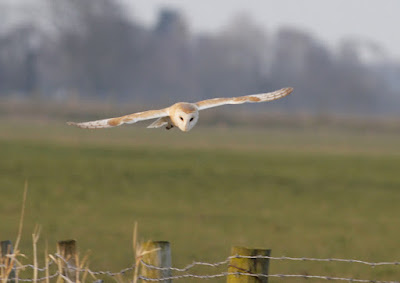We are enjoying a good few days of settled weather. Despite the northerly origins of the winds which produce cold nights and cool days, many birds are making progress in their spring migration. This is especially noticeable at our Oakenclough ringing site on the western edge of the Pennine Hills where Siskins, Lesser Redpolls and Goldfinches have dominated recent visits, either in mist nets or overhead on visible migration. In searching local websites and blogs this migration seems to be much less evident in coastal areas or even missing completely. It’s tempting to say that many birders turn out later in the day than the average ringer? Or maybe it’s just that the birds use inland migration routes in the early spring?
I’m not complaining about seeing the same species but instead enjoy recent days as an opportunity to record our observations and collect yet more data about migration. So Friday began with a scrape of the windscreen ice, a thirty minute drive into the hills and a 0630 meet with Andy for another ringing session.
A cold easterly breeze reduced today’s catch somewhat but we still finished up with 45 birds of which 43 were of the finch family. It was a rather striking result in producing 22 Goldfinch, 12 Lesser Redpoll, 6 Siskin, 3 Chaffinch, 1 Great Tit and 1 Blue Tit
One of today’s Lesser Redpolls proved to be a “control”. It carried a BTO ring but of a letter and number sequence we did not recognise (D700 etc) so had been ringed elsewhere in the UK by another ringer. We will find out the details of this bird in due course once the capture from today is computerised and sent to the BTO.
Lesser Redpoll
The British Trust for Ornithology (BTO) Bird Atlas 2007-11 relates a success story for the
Lesser Redpoll. Despite a 16% decrease in occupied squares in England
since the 1968-72 Breeding Atlas, there was a corresponding
26% increase in Scotland and a 163% increase in Ireland. We can be
fairly certain all the Lesser Redpolls we are seeing at the moment
are on their way north and west to Scotland and Ireland.
On a point of interest to readers
outside of the UK, the Lesser Redpoll was elevated to full species
status by British Ornithologists’ Union (BOU) in 2001 whereas in Ireland
and elsewhere it continues to be treated as a race of Common Redpoll.
The Lesser Redpoll is widespread throughout the UK whereas the Common
Redpoll is a scarce visitor to Britain from northern Europe, Greenland
and Iceland. Prior to 2001 birders and ringers who encountered these
paler, larger and uncommon visitors referred to them simply as “Northern
Redpolls”. Only after 2001 could we put a “tick” in the box next to
Common Redpoll.
Lesser Redpoll
The Siskins we caught today are on their way to more northerly parts of the UK, potentially to Norway, just over the North Sea from Scotland.
Siskin
The British Trust for Ornithology (BTO) Bird Atlas 2007-11 tells us that since the 1968-72 Breeding Atlas the Siskin has enjoyed a “spectacular” increase of 166% in the number of occupied 10km squares. Gains were achieved in Wales and large parts of Ireland. In Scotland, Siskins have spread into the northeast and onto the Northern Isles and the Outer Hebrides
Siskin
It was good to see the Goldfinch at the top of the scoresheet today. The Goldfinch is now so abundant we often forget that it too is a partial migrant which returns north at this time of year. Because Goldfinches are always around in wintertime, albeit in reduced numbers, it is not always easy to spot the spring arrivals.
Goldfinch
The Goldfinch has a chequered history in the UK, a past and present story which is replicated here in the county of Lancashire where during the late 19th century it was almost extinct as a breeding species.
The then status of the Goldfinch is described in a book from 1892 - The Birds of Lancashire by F. S. Mitchell.
“The Goldfinch is resident, but so decreased in numbers as to be almost extinct. The march of agriculture is one great reason for this; waste lands where thistle is its favourite food, groundsel and nettles used to grow in plenty, being now so largely brought under cultivation. The bird-catcher too (or as he is more commonly called the "tuttler" or "touter" i.e. one who entices), is the deadly enemy of the Goldfinch, and any stray individuals are at once captured to satisfy the exigencies of the demand from the large towns.”
The Goldfinch hung on in there until during the 1980’s there came a sudden revival in its fortunes.
The following information is also taken from the BTO Atlas 2007-11.
“Since the 1990s the UK Goldfinch population has exploded, a phenomenon almost entirely explained by improved annual survival. During 1995-2010 there was a 91% increase in the UK breeding population and a 158% increase during 1998-2010 in Ireland.
The Goldfinch owes much of its recent success to adapting to and exploiting bird feeding stations in suburban gardens and elsewhere. Goldfinches were recorded in 50-60% of gardens in Britain in 2011 with a similar pattern evident in Ireland with Goldfinches recorded in 80% of gardens.”
Goldfinch
Stay tuned. There will be more finch tales soon from Another Bird Blog.
Linking today to Stewart's World Bird Wednesday, Anni's Birding and Eileen's Saturday.
Linking today to Stewart's World Bird Wednesday, Anni's Birding and Eileen's Saturday.


























































.jpg)














